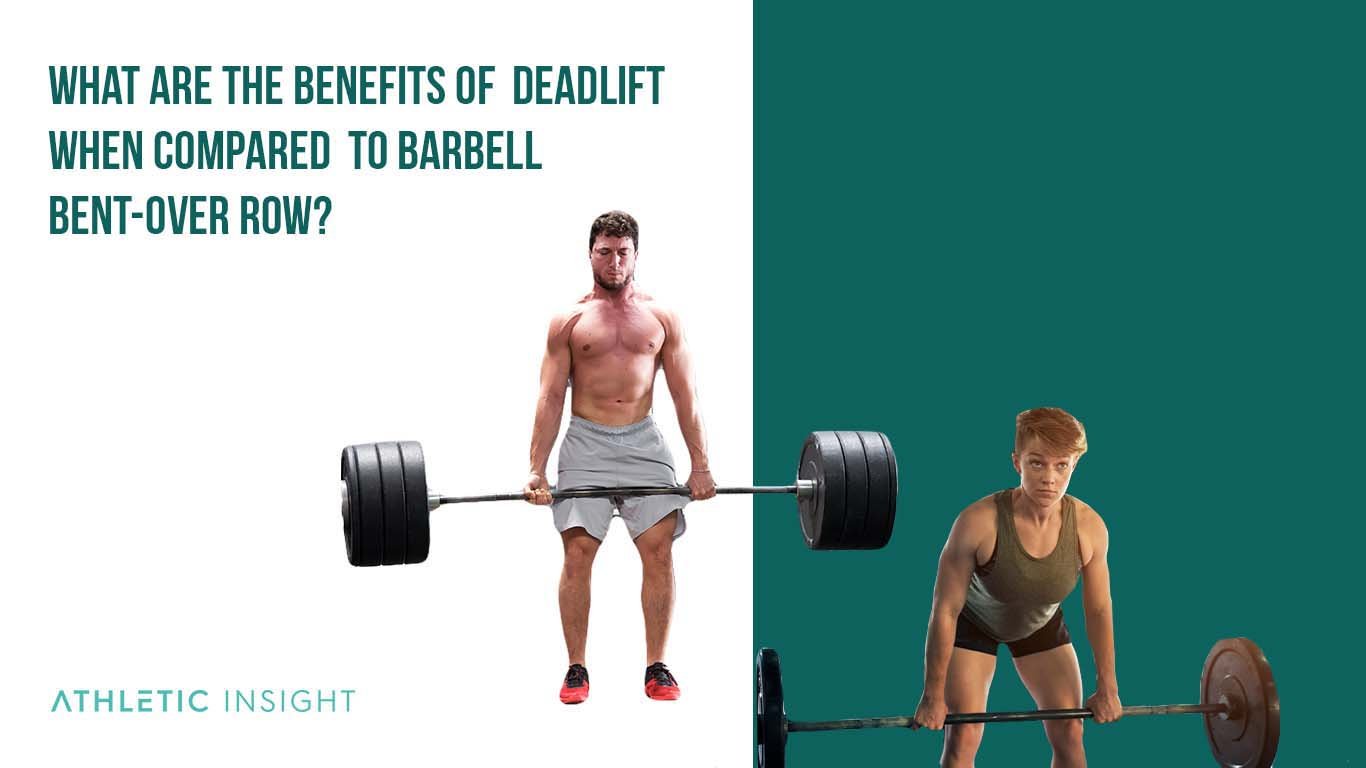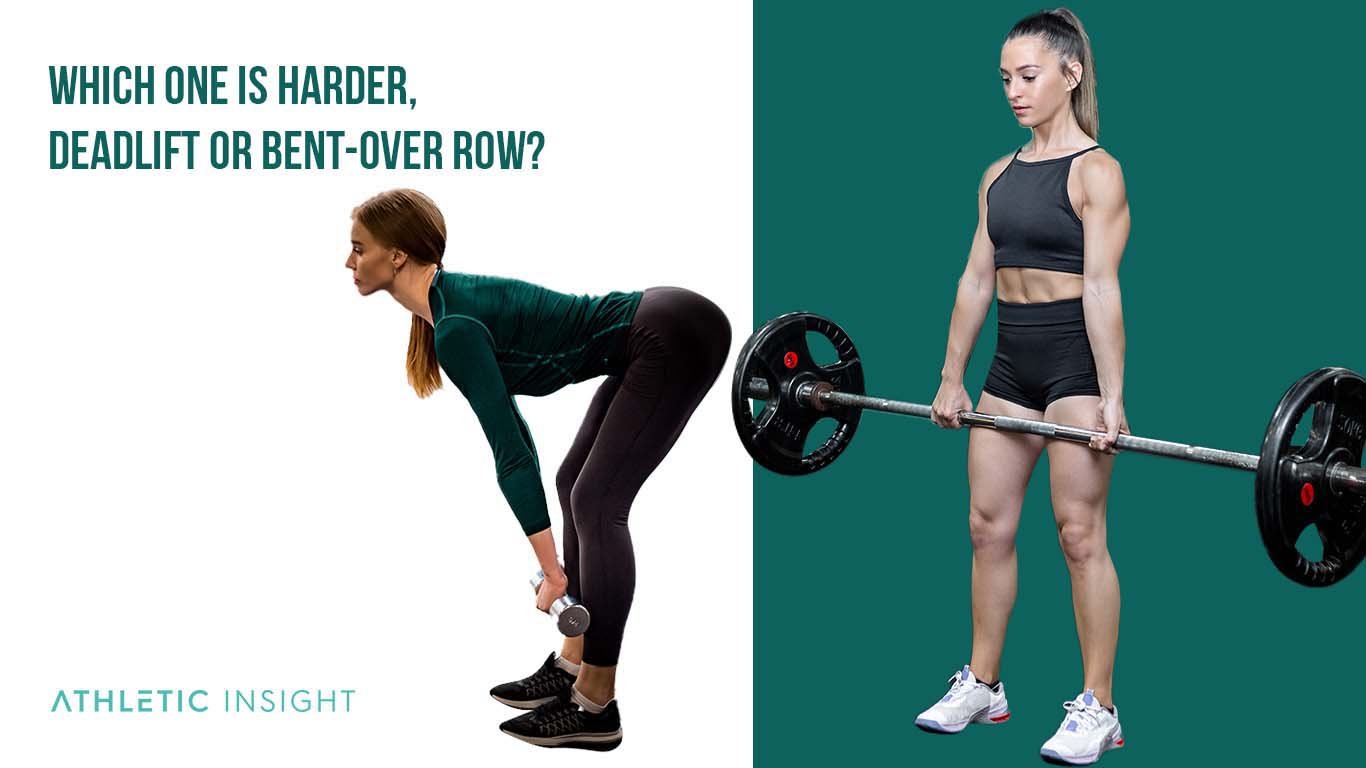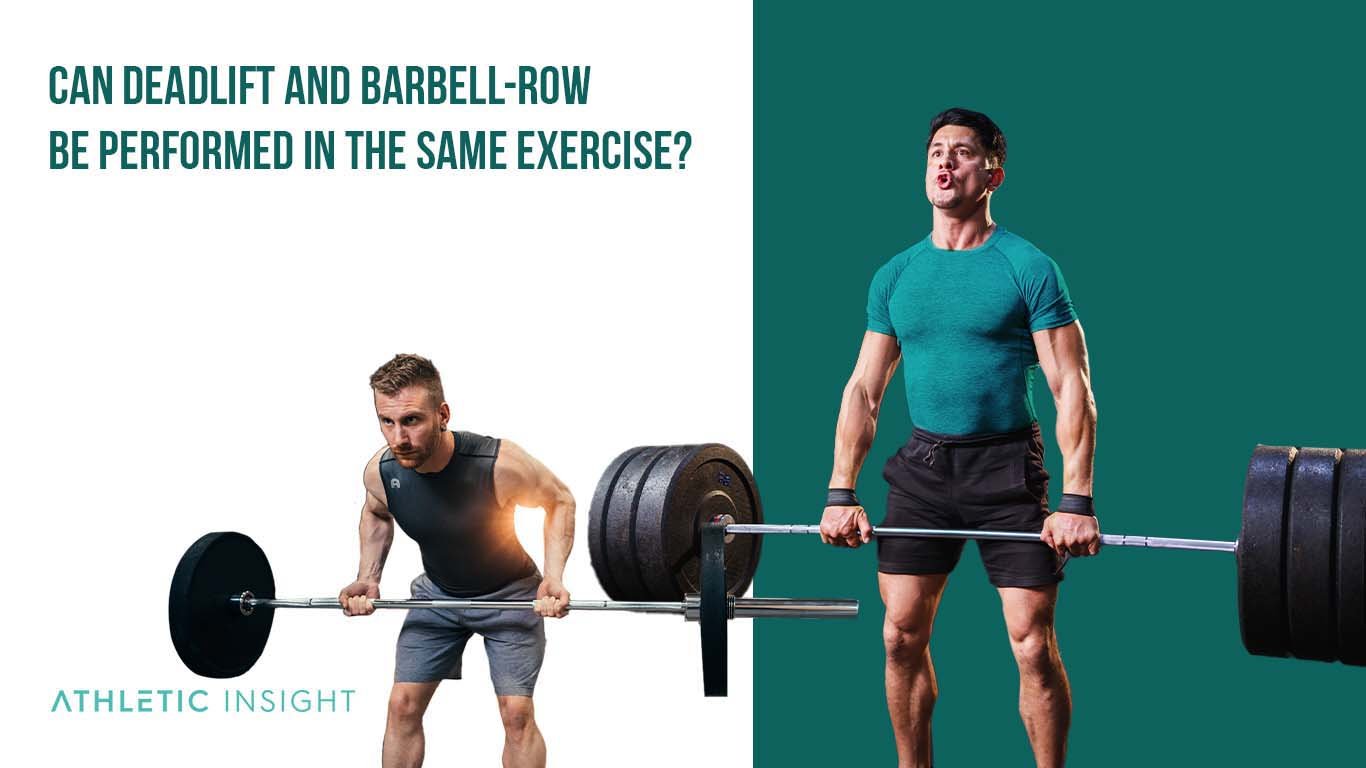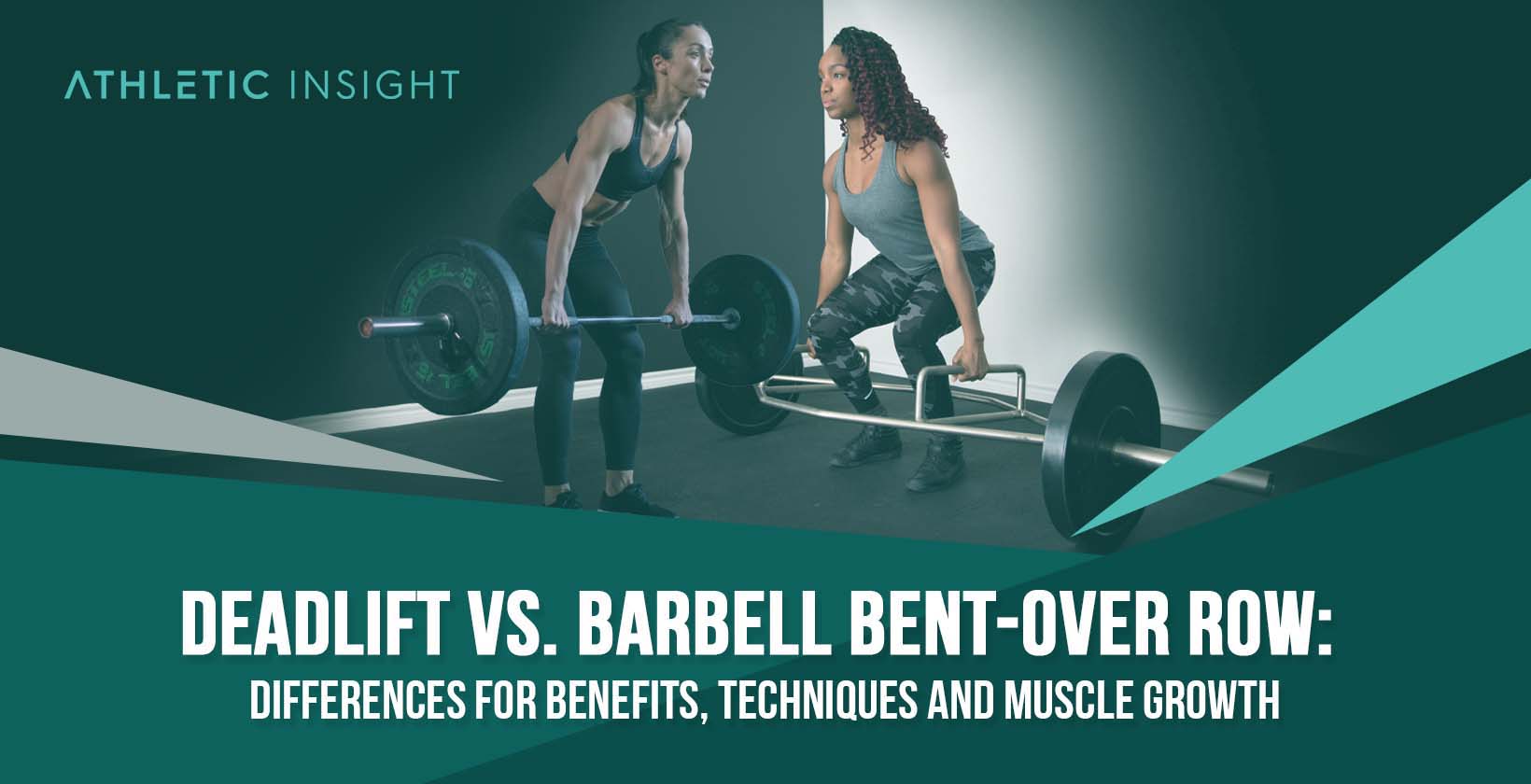Deadlifts and barbell row both increase strength and muscle growth in athletes’ backs. However, they target different muscle groups and provide contrasting benefits.
A deadlift is a weight training exercise in which an athlete lifts a loaded barbell or other forms of weight from the floor to hip height, bringing their torso perpendicular to the floor. Then, they lower the weight, or in some cases, allow it to drop.
A bent-over row or barbell row requires an athlete to bend over so that their torso is parallel or near parallel to the ground. From there, they hold a weighted barbell with arms outstretched and shoulders engaged. Then, the athlete pulls the barbell towards their abdomen, bringing their elbows back.
Though both barbell bent-over rows and deadlifts are basic movements, they can provide varying degrees of difficulty to athletes. How difficult each exercise is will depend on the athlete’s mobility, coordination, and strength.
The difficulty level will also depend on the variation of the exercise that the athlete chooses to perform. Both bent over rows and deadlifts can be made more difficult by changing simple things, such as bar placement or weight stimulus. Using a slightly altered technique or placing the weight at a deficit can increase the difficulty of the movements.
Both of these weight training exercises focus on the back, but the exact muscle group targets vary greatly. Deadlifts focus on large, lower back muscle groups like the hamstrings, glutes, and lower back. Alternatively, barbell rows stimulate the upper back muscle groups, such as the latissimus dorsi, rear deltoids, and traps.
Trainers and athletes often compare deadlifts and barbell rows because they both focus on back muscles, but the differences in muscle targets mean that these two exercises accomplish different things.
For example, each exercise will have a different effect on an athlete’s mood. Strength training, in general, has been shown to help with mood. It can lower symptoms of depression by releasing hormones like testosterone. Training with weights also encourages mindfulness; it’s hard to think of anything else when you have something heavy to pick up.
However, when it comes to promoting a better mood, deadlifts are likely more effective than bent over rows. That’s because athletes usually perform deadlifts at a heavier weight. It’s also because deadlifts stress the larger muscle masses around the hips and upper legs.
The greater stress on larger body systems creates a more significant hormonal release and requires more mindfulness to train, meaning deadlifts are more likely to affect an athlete’s mood.
Heart rate is another area where deadlifts can provide benefits. Lifting something heavy from the floor to one’s hips can significantly increase heart rate for a few minutes after the lift. However, bent-over rows or a combination deadlift with a bent-over row will likely produce more significant cardiovascular benefits.
Barbell rows usually require the athlete to use a lighter weight. Because it’s light, the athlete is also more likely to perform the exercise with high repetitions. High repetitions increase heart rate for longer periods, up to twenty minutes after lifting, creating more cardiovascular endurance than a single heavy contraction.
Both barbell rows and deadlifts can create significant muscle growth, but again, where this growth occurs differs significantly. While deadlifts can strengthen the back of the legs and lower back, they’re less likely to increase bulk on the arms and upper back.
Bent over rows, however, are capable of adding tremendous bulk to the sides and upper portion of the back. When an athlete performs them traditionally, with two arms holding the bar, they also build the core, which must stabilize throughout the movement.
So, though these two strength exercises both focus on the back of the body, their benefits, techniques, and muscle stimuli vary significantly.
What Are the Benefits of Deadlift When Compared to Barbell Bent-Over Row?
When comparing the deadlift vs. barbell row, the deadlift has a few advantages. These include the following.
- Muscle growth in hip extensors
- Improves stamina in explosive movements
- Improves bone strength in hips
- Builds back strength
- Builds neural adaptations for better sports performance
1. Muscle Growth in Hip Extensors
Hip extensors refer to the muscles in the hips, glutes, and lower back. These muscles are major movers for the body, allowing athletes to accelerate up and forward from the point of hip flexion.
Deadlifts activate hip extensors, helping to strengthen them. Research shows that deadlifts are superior at activating the biceps femoris, a vital portion of the hip extensors, even over other hip extensor-focused exercises like hip thrusts.
2. Improves Stamina in Explosive Movements
By activating their hip extensors, athletes can improve their explosive movements, especially their jump and sprint performance. Volleyball players, basketball players, and high jumpers alike will all benefit from deadlift exercises.
On top of activating hip extensors, deadlifts also increase the rate of force development and increase tendon stiffness, both of which lead to more stamina in explosive movements.
Increasing the rate at which an athlete can develop force can create more power in their jump or sprint, resulting in more height and speed.
Tendons and muscles work in tandem to create movement. When a tendon is looser, it absorbs some of the muscle’s contraction force, taking away some of the muscle’s power.
Performed regularly, deadlifts increase tendon stiffness allowing the muscle-tendon unit to work more efficiently. The tendon no longer absorbs the force of the contraction, giving the athlete more power in their movements.
3. Improves Bone Strength in Hips
Strength training improves bone density, making it a vital practice for athletes and non-athletes alike. There’s a direct relationship between bone density and muscle growth. If someone puts on more muscle in their hips and lower back, the bones in those areas will also grow denser.
Bone density, or lack thereof, is a crucial indicator of osteoporosis, which can lead to bone fractures from minor falls. A fractured pelvic bone is difficult to recover from and frequently leads to death in adults over 50 years old.
Deadlifting builds muscle and, therefore, bone density in the hip bones, keeping athletes and non-athletes safe from deterioration as they grow older.
4. Builds Back Strength
Deadlifts are long and complex movements capable of working the majority of the posterior chain. The posterior chain extends from the base of the neck to the back of the ankles and includes all of the muscles therein.
A strong posterior chain can prevent injury and improve athletic performance. It can help athletes counteract unexpected forces on their muscles which they’re likely to experience while playing contact sports. It also helps improve posture.
Romanian deadlifts, in which the athlete does not bend their knees, are especially good at building posterior chain strength, but any type of deadlift will be effective.
5. Build Neural Adaptations for Better Sport Performance
Deadlifts are a complex, full-body movement. To perform one, the neuromuscular system has to recruit and fire more muscle fibers than other isolated exercises require.
The number of fibers needed will depend on the amount of resistance the athlete feels. In other words, it will depend on how heavy the deadlift is.
When playing sports, whether it be basketball, football, or track, creating neural adaptations that allow more muscle fibers to fire at once will give the athlete access to more power. So, practicing heavy deadlifts can be helpful in improving sports performance.
What Are the Benefits of Bent-Over Row When Compared to Deadlift?
When comparing barbell row vs. deadlift exercises, barbell rows also accomplish a few things that deadlifts do not.

- Increases muscle growth in the mid and upper back
- Increases bone strength in the spine and wrists
- Build back strength in upper and mid back
- Improves stamina in other pulling movements
- Builds neural adaptations to fight performance fatigue
1. Increases Muscle Growth in Mid and Upper Back
The latissimus dorsi and trapezius dominate the upper back. The lats span the width of the back in a large V-shape, while the trapezius starts at the base of the neck, spreads across the shoulders, and then extends down.
When an athlete performs a barbell row, they target these muscles, as well as the rear deltoids, which run along the back of the shoulders. Stimulating all three of these muscle areas increases effectively their size and definition.
2. Increases Bone Strength in Spine and Wrists
Strength training increases bone density in the areas that an athlete trains. With a bent-over row, athletes place a significant demand on the wrists, from holding the barbell, and along the spine, which must stabilize the athlete throughout the exercise.
An athlete can increase bone density in both of these crucial areas by practicing traditional barbell rows or a variation regularly.
3. Builds Back Strength in Upper and Mid Back
Strengthening the upper back muscles, particularly the latissimus dorsi, helps pull the shoulders back into proper alignment with the spine. Doing this can significantly benefit one’s posture, counteracting the adverse effects of a modern lifestyle that includes sitting most of the day.
More upper back strength can also improve an athlete’s performance overall. Any movement that involves the shoulders or upper back, whether it’s swinging a tennis racket or tackling an opponent, will benefit from increased upper and mid back strength.
By building upper back strength, athletes will also improve shoulder stability.
In many sports, athletes are prone to shoulder injuries that can be debilitating. Bent-over rows require athletes to move their shoulder blades from a protracted to a retracted position, increasing scapular stability.
Increased scapular stability helps prevent shoulder injuries, like rotator cuff tears and subacromial impingement, both of which are common in many sports.
4. Improves Stamina in Other Pulling Movements
Bent-over rows require athletes to maintain a hip hinge throughout the movement. This forces the hamstrings, lower back, and abdominal muscles to activate in order to stabilize the athlete.
These same muscles need to fire when pulling anything off the ground, as an athlete would in a deadlift. So, bent-over rows increase muscle stamina for other pulling movements, whether they be deadlifts or something sports specific.
5. Builds Neural Adaptations to Fight Performance Fatigue
Typically, athletes perform bent-over rows as an accessory movement, meaning they don’t practice this exercise until the end of their training session when they’re already fatigued.
Barbell rows work well towards the end of a weightlifting session because the athlete usually needs to perform them at a lighter weight than they would other exercises like deadlifts or squats.
By practicing bent-over rows when they’re already fatigued, the athlete helps build crucial neural adaptations.
These adaptations teach the brain to recruit muscles it normally wouldn’t rely on. By activating these muscles, the brain learns how to keep going when fatigued, allowing athletes to prepare themselves for what they may feel at the end of a game or meet.
What Muscles Does Deadlift Affect More Than Bent-Over Row?
Looking at deadlifts vs. rows, the deadlift affects more muscles along the lower back, hips, and upper legs. Primarily, these include the following.
- Thighs (Quadricep femoris)
- Lower back (Erector spinae)
- Butt (Gluteus maximus)
Secondarily, deadlifts activate the following muscle groups.
- Hamstrings (Semitendinosus, semimembranosus, and biceps femoris)
- Inner Thighs (Abductors and adductors)
- Calves (Triceps surae)
Though deadlifts also activate the trapezius and latissimus dorsi, in the upper back, bent-over rows are more effective for stimulating that area.
What Muscles Do Barbell Row Affect More Than Deadlift?
Barbell rows have a more significant effect on the muscles of the upper back than deadlifts do. These include the following.
- Lats (Latissimus Dorsi)
- Rhomboid (Rhomboideus major and minor)
- Rear Delts (Posterior deltoids)
- Traps (Trapezius)
Secondarily, barbell rows will stimulate the biceps (biceps brachii). It will also force the athlete to use the hamstrings and abdominals to stabilize themselves. However, a deadlift puts more strain on the hamstrings than a barbell row can.
Which One Is Harder, Deadlift or Bent-Over Row?
The deadlift is harder than the bent-over row for most athletes. Typically athletes perform deadlifts at a heavier weight, making them more challenging to train. Heavier loads put more strain on the central nervous system, which increases feelings of fatigue and can impair motor neuron firing.

However, deadlifts are somewhat intuitive. Picking something up off the ground is a functional movement that most people face on a daily basis. Athletes are less likely to be familiar with the proper technique for a bent-over row which requires both core stability and coordination to perform.
The difficulty of the movement may also depend on the variation of the exercise. For example, a deficit deadlift is much more difficult than a standard deadlift. Setting the weight at a deficit requires the athlete to have greater mobility, a more extended range of motion, and the ability to withstand more time under tension than they would with other lifts.
That said, a heavy Pendlay row or bent-over barbell deadlift, in which the athlete brings the weight all the way down to the floor between pulls, may be more difficult than a regular deadlift or a standard row. This is because it, like the deficit deadlift, requires more mobility, a longer range of motion, and more time under tension.
Which One Is Better for Beginners, Bent-Over Row or Deadlift?
Both deadlifts and bent-over rows are effective exercises for beginners, but the deadlift is the more intuitive and functional movement. Picking something heavy up off the ground is something that even a beginner has likely accomplished in the past.
Deadlifts are also closer to a full-body movement. They activate large muscle groups that are responsible for jumping, sprinting, and generally moving explosively. So, beginners may perceive bigger benefits faster if they focus on deadlifts.
Barbell rows, meanwhile, require a lot of core stabilization and are easy to perform poorly. Beginners may struggle with maintaining a parallel position to the floor and often end up standing too upright.
Both exercises can put too much strain on an underdeveloped lower back, though, which means beginners must be careful of form in practicing either one.
Romanian deadlifts, in which the legs stay straight rather than bending, maybe a good option for beginners who hope to build their posterior chain, preventing the injuries that traditional deadlifts or bent over rows can aggravate.
Can Deadlift and Barbell-Row Be Performed in the Same Exercise?
Yes, the deadlift and barbell-row can be performed in the same exercise. This combination exercise is known by many names and can be called a deadlift barbell row, a barbell deadlift to row, or simply deadlift rows.

A deadlift bent-over row consists of a standard deadlift, bringing the loaded bar to hip height. From there, the athlete rebends at the hips to get into the row position. Next, they pull the bar back towards their abdomens before releasing it back to the ground.
This complex, combination movement works both the upper and lower back. It will also increase the athlete’s heart rate, helping to improve cardiovascular endurance.
Since it’s such a technical and lengthy movement, athletes usually perform it at a much lower weight than they would an isolated deadlift or row.
Using lower weights can make this exercise suitable for novice athletes as well. However, if beginner athlete is worried about straining their lower back, they may decide to change the movement from a Romanian deadlift to a row instead.
What Are the Back Exercise Programs That Include Barbell-Row and Deadlift?
The back exercise programs that include barbell-row and deadlift are many and varied. Several classic exercise programs include barbell-rows and deadlifts as complementary back exercises.
Deadlifts strengthen the lower back and glutes while barbell rows strengthen the upper back region, so using them together is a common and effective method for building total back strength.
One example of this is the conjugate method, developed by Soviet Union scientists and made famous by Louie Simmons of Westside Barbell.
In the conjugate method, athletes train their upper bodies two days a week and their lower bodies two days a week.
The days are further divided into dynamic and max-effort sessions, with heavy lifts concentrated on the max-effort day. Lightweight, speed-focused lifts and assistance exercises are concentrated on dynamic days.
To use deadlifts and barbell rows together in this program, the athlete performs heavy deadlifts on the max-effort lower body day. Then, they would add in bent-over rows as an assistance exercise on their dynamic upper body day.
The 5×5 method, popularized by Arnold Schwarzenegger, is another program where you commonly see deadlifts and rows together.
In the 5×5 method, deadlifts are one of the main focus lifts, alongside squats, bench press, and military presses. On top of the four major lifts, athletes engage in accessory work which usually includes variations of the bent-over row.
Which One Is Better for Advanced Athletes, Deadlift or Barbell Row?
Many assume the deadlift is better for advanced athletes over the barbell row. In truth, advanced athletes will benefit from both the deadlift and the barbell row. Depending on their sport, one exercise may be superior to the other.
Football and soccer players, for example, might find greater benefit in training deadlifts than they do barbell rows. Deadlifts will give them the explosive power they need on the field.
Tennis players, however, may find that barbell rows are a more productive exercise, as it can help them stabilize their shoulders.
For advanced athletes, it will be essential to choose a suitable exercise variation, whether they’re deadlifting or performing a bent-over row.
For example, football players may benefit most from a sumo deadlift, where their stance is wide-legged. The broad stance is similar to what they experience during blocks and drives throughout the game.
A track athlete, or any athlete that relies heavily on cardiovascular endurance, might find more significant benefits in a combination exercise like a deadlift bent over row. This will strengthen their entire back while getting their heart rate up.
Is Deadlift Better Than Barbell Row for Strength?
Yes, overall, a deadlift is better than a barbell row for building strength. Deadlifts activate large muscle groups that promote power and explosive movement. As a result, they can improve jumping and sprinting capabilities, creating a stronger, more powerful athlete.
That said, barbell rows are better at building back strength in isolation. They’re also better for encouraging shoulder stabilization.
Stabilization is essential to attain alongside brute strength as it can help prevent injuries. So, even though deadlifts are better for building muscle throughout the body, barbell rows still have a crucial place in most training programs.
What Are the Disadvantages of Deadlift When Compared to Barbell Row?
When comparing deadlifts to barbell rows, there are several disadvantages to deadlifting. They can place too much strain on the lower back and aren’t ideal for building visible bulk.
They also won’t do much for shoulder stabilization, nor will they fix bad posture. Barbell rows, however, can help with many of those things.
- Barbell rows build visible bulk in the upper back, including lats, rhomboids, and traps.
- Barbell rows build bone strength in the spine which must stabilize the athlete throughout the movement. They also increase bone density in the wrists because athletes must maintain their grip on a weighted bar.
- Barbell rows build strength in the upper and mid back. In doing so they help to stabilize the shoulders, preventing injuries.
- Barbell rows improve stamina in other pulling movements, such as deadlifts, making them ideal accessory lifts.
- Athletes usually practice bent-over rows at the end of their training sessions when they’re fatigued. This promotes neural adaptations that will help them at the end of a performance, game, or meet.
What Are the Disadvantages of Bent-Over Row When Compared to Deadlift?
Bent-over rows are excellent for certain things, but they have a few glaring disadvantages when compared to deadlifts.
Bent-over rows don’t work the muscle groups that give athletes the explosive power necessary for most sports. They’re less of a full-body exercise than deadlifts and more of an accessory movement.
Deadlifts outshine bent-over rows in many situations.
- Deadlifts activate hip extensors, strengthening the muscles that allow athletes to accelerate up and forward.
- Deadlifts have been shown to increase power and stamina in explosive movements. They increase vertical jumps and improve sprints.
- Deadlifts increase bone density in the hips, helping to promote long-term health in athletes and other fitness fanatics.
- Deadlifts build posterior chain strength, creating a stronger back and preventing potential injuries.
- Deadlifts force the neuromuscular system to recruit more muscle fibers, giving the athlete neural adaptations to be more powerful in their sport.



